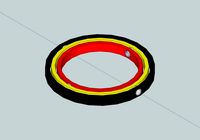Thingiverse

Gyroscope 3D by vasantha1
by Thingiverse
Last crawled date: 3 years, 1 month ago
The organization I work for (Children’s Science Center of No Va) has a Summer Challenge! We have teamed up with AFCEA NOVA (Armed Forces Communications & Electronics Association) for a Walk, Run, Bike Challenge. Three military veterans from AFCEA NOVA will bicycle across the United States while raising money to donate to the Children’s Science Center. The trip will take three months and cover 4,200 miles.
To support the Summer Challenge, and educate children and their families how to EXPLORE/INSPIRE/CREATE hands-on activities related to Bike Riding, exercise, and nutrition, I came up with this project-Gyroscope 3D. Participants will use TinkerCad or AutoDesk123Design or similar 3D design software and convert and import images, generate text, adding specific information and then manipulate individual objects to create a unique 3D model of toy Gyroscope.
GYROSCOPE 3D PROJECT
Introduction
Bicycle physics is a broad and complex subject, perhaps more so than one can imagine. Although the number of components of a bicycle is small, the interaction between them and the dynamic principles involved, is complicated. This is especially true with regards to bicycle stability, which is the result of a complex dynamic interaction within the bike-rider system.
Bicycles are inherently stable when riding. Even rider-less bicycles are stable if given enough forward velocity. Much effort has gone into analyzing the factors which make a bicycle stable. When analyzing bicycle stability it is common to use two parameters; the lean angle and steering angle of the bike. The lean angle is the left and right angle the bike frame makes with a vertical plane, and the steering angle is the angle the front wheel makes with the plane of the bike (containing the bike frame).
Gyroscopic Effects On Bicycle Stability
A common belief is that gyroscopic effects by themselves are what make a bike stable. This is actually not the case. Although gyroscopic effects do play a role, they are merely part of a much larger dynamic interaction taking place between the various bicycle components, which altogether is what ultimately makes a bicycle stable during riding. The design of a bicycle, and the configuration of the different components, have been optimized through the ages (largely through trial and error), to make it as stable as possible.
The role of the gyroscopic effect in most bike designs is to help steer the front wheel into the direction of a lean. This phenomenon is called precession and the rate at which an object precesses is inversely proportional to its rate of spin. The slower a front wheel spins, the faster it will precess when the bike leans, and vice versa.[ The rear wheel is prevented from precessing as the front wheel does by friction of the tires on the ground, and so continues to lean as though it were not spinning at all. Hence gyroscopic forces do not provide any resistance to tipping.
At low forward speeds, the precession of the front wheel is too quick, contributing to an uncontrolled bike’s tendency to oversteer, start to lean the other way and eventually oscillate and fall over. At high forward speeds, the precession is usually too slow, contributing to an uncontrolled bike’s tendency to understeer and eventually fall over without ever having reached the upright position. This instability is very slow, on the order of seconds, and is easy for most riders to counteract. Thus a fast bike may feel stable even though it is actually not self-stable and would fall over if it were uncontrolled.
To support the Summer Challenge, and educate children and their families how to EXPLORE/INSPIRE/CREATE hands-on activities related to Bike Riding, exercise, and nutrition, I came up with this project-Gyroscope 3D. Participants will use TinkerCad or AutoDesk123Design or similar 3D design software and convert and import images, generate text, adding specific information and then manipulate individual objects to create a unique 3D model of toy Gyroscope.
GYROSCOPE 3D PROJECT
Introduction
Bicycle physics is a broad and complex subject, perhaps more so than one can imagine. Although the number of components of a bicycle is small, the interaction between them and the dynamic principles involved, is complicated. This is especially true with regards to bicycle stability, which is the result of a complex dynamic interaction within the bike-rider system.
Bicycles are inherently stable when riding. Even rider-less bicycles are stable if given enough forward velocity. Much effort has gone into analyzing the factors which make a bicycle stable. When analyzing bicycle stability it is common to use two parameters; the lean angle and steering angle of the bike. The lean angle is the left and right angle the bike frame makes with a vertical plane, and the steering angle is the angle the front wheel makes with the plane of the bike (containing the bike frame).
Gyroscopic Effects On Bicycle Stability
A common belief is that gyroscopic effects by themselves are what make a bike stable. This is actually not the case. Although gyroscopic effects do play a role, they are merely part of a much larger dynamic interaction taking place between the various bicycle components, which altogether is what ultimately makes a bicycle stable during riding. The design of a bicycle, and the configuration of the different components, have been optimized through the ages (largely through trial and error), to make it as stable as possible.
The role of the gyroscopic effect in most bike designs is to help steer the front wheel into the direction of a lean. This phenomenon is called precession and the rate at which an object precesses is inversely proportional to its rate of spin. The slower a front wheel spins, the faster it will precess when the bike leans, and vice versa.[ The rear wheel is prevented from precessing as the front wheel does by friction of the tires on the ground, and so continues to lean as though it were not spinning at all. Hence gyroscopic forces do not provide any resistance to tipping.
At low forward speeds, the precession of the front wheel is too quick, contributing to an uncontrolled bike’s tendency to oversteer, start to lean the other way and eventually oscillate and fall over. At high forward speeds, the precession is usually too slow, contributing to an uncontrolled bike’s tendency to understeer and eventually fall over without ever having reached the upright position. This instability is very slow, on the order of seconds, and is easy for most riders to counteract. Thus a fast bike may feel stable even though it is actually not self-stable and would fall over if it were uncontrolled.
Similar models
grabcad
free

Gyroscopic bike stabilizer
...are more likely to have stability problems. in these particular cases the gyroscope motor use the battery from the support motor.
cg_trader
$10

BIcycle
...cations. their stability, comfort and ease of use make them popular with novice cyclists, casual riders, commuters, and children.
grabcad
free

Bicycle Roller
...can usually be adjusted to match the bicycle's wheelbase.
youtube - https://www.youtube.com/channel/uczfrwbls5z_hmyop_jipkng
grabcad
free

Bike Accessory Challenge - Steering Wheel
...bike accessory challenge - steering wheel
grabcad
ergonomic, bicycle steering designed suitable for printing on 3d printer . . .
cg_trader
$12

Bicycle in Blender
...lender 3.0.0 bicycle cyclist wheel bike biker seated ride vehicle rim cycling motorbike tyre biking tire action rider cycle spoke
thingiverse
free

Bike Front Wheel Holder
... dimensions, but should work for up to 39mm wide.
tire width: 26mm - 39mm
tire diameter: 266mm
original fusion360 file included.
thingiverse
free

Front Wheel with Hard insert for TAMIYA T3-01 by jkyang
...3-01 by jkyang
thingiverse
5-spoke front wheel for tamiya t3-01 dancing rider.
the hard insert came up more steering and stable.
cg_trader
$10

Handlebar Bike R
...y harley racing cycling harley davidson harley racing harley davidson motogp formula biking roadbike foldable citybike sport bike
3dwarehouse
free

BMX Bike with Rider - Sketchy
...th rider - sketchy
3dwarehouse
bmx rider rides around a turn table. #arms #bike #bmx #legs #pedal #riding #robot #spokes #wheels
grabcad
free

Electric Bike Frame
...y and safely. it is a critical component that influences the performance, handling, and overall riding experience of a motorbike.
Gyroscope
turbosquid
$1

Gyroscope
...ree 3d model gyroscope for download as max, fbx, 3ds, and obj on turbosquid: 3d models for games, architecture, videos. (1581593)
turbosquid
$1

Gyroscope
... available on turbo squid, the world's leading provider of digital 3d models for visualization, films, television, and games.
3d_export
$10

Gyroscope 3D Model
...gyroscope 3d model
3dexport
gyroscope toy model 3dprinting
gyroscope 3d model pisarevg 50094 3dexport
3d_export
$5

Gyroscope 3D Model
...gyroscope 3d model
3dexport
gyroscope 3d model pisarevg 78928 3dexport
turbosquid
$28

Brass Gyroscope
...ee 3d model brass gyroscope for download as max, fbx, and obj on turbosquid: 3d models for games, architecture, videos. (1629790)
3ddd
free

Foucault's Iron Orb
...orb restoration hardware nineteenth century experimental physicist léon foucault's gyroscope inspired our openwork globe. its double-gimbal frame is built...
sketchfab
$5

Gyroscope
...gyroscope
sketchfab
gyroscope exported from unity. - gyroscope - buy royalty free 3d model by dbr3d
thingiverse
free

Gyroscope by abapemilo
...gyroscope by abapemilo
thingiverse
20170715 gyroscope
thingiverse
free

Gyroscope by CBUEngineering
...gyroscope by cbuengineering
thingiverse
gyroscope with weighted middle section
thingiverse
free

Gyroscope by ntdwyer
...gyroscope by ntdwyer
thingiverse
first edition of my pull-string gyroscope design.
